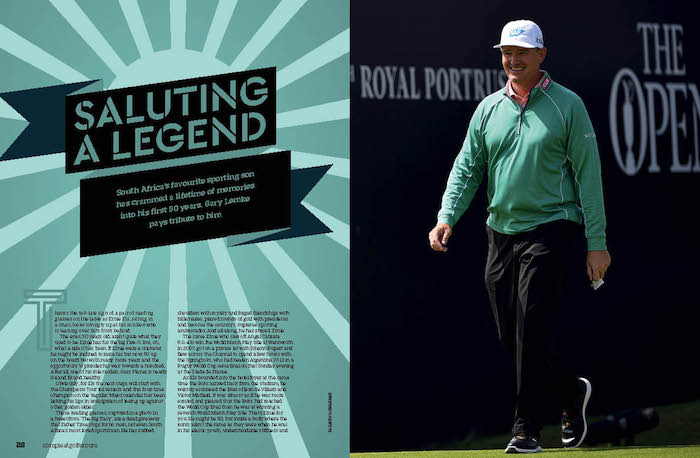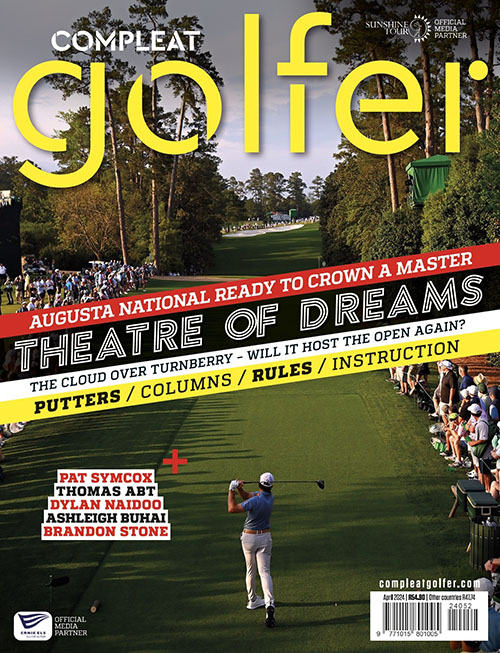South Africa’s favourite sporting son, Ernie Els, has crammed a lifetime of memories into his first 50 years. GARY LEMKE pays tribute to him in Compleat Golfer.
There’s the tell-tale sign of a pair of reading glasses on the table as Ernie Els, sitting in a chair, looks lovingly up at his son Ben who is leaning over him from behind.
The eyes, 50 years old, aren’t quite what they used to be. Ernie has hit the big Five-O. But, oh, what a ride it has been. If Ernie were a cricketer he might be inclined to raise his bat now, 50 up on the board but with many more years and the opportunity to plunder his way towards a hundred. After all, one of his role models, Gary Player, is nearly 84 and fit and healthy.
Obviously, for Els the next steps will start with the Champions Tour for seniors and this four-time champion on the ‘regular’ Major calendar has been licking his lips in anticipation of teeing up against other ‘golden oldies’.
Those reading glasses, captured in a photo in a tweet from ‘The Big Easy’, are a dead giveaway that Father Time stops for no man, not even South Africa’s most loved sportsman. He has rubbed shoulders with royalty and forged friendships with billionaires, played rounds of golf with presidents and become the country’s supreme sporting ambassador. And all along, he has stayed ‘Ernie’.
The same Ernie who saw off Angel Cabrera 6 & 4 to win the World Match Play title at Wentworth in 2007, got on a private jet with Johann Rupert and flew across the Channel to spend a few hours with the Springboks, who had beaten Argentina 37-13 in a Rugby World Cup semi-final on that Sunday evening at the Stade de France.
As Els bounded into the hotel foyer at the same time the Boks arrived back from the stadium, he warmly embraced the likes of Jean de Villiers and Victor Matfield. It was almost as if he was more excited and pleased that the Boks had reached the World Cup final than he was at winning a seventh World Match Play title. That’s Ernie for you. He might be 50, but inside a body where the joints aren’t the same as they were when he was in his elastic youth, understandable stiffness and eyes that aren’t what they used to be, there’s still a kid waiting to get out.
So, what happens next?
Occupying his focus is The Presidents Cup, where he is a proud captain of the International team that will take on the United States at Royal Melbourne in December. ‘I’m excited about this and have been working hard to get the right balance. I’ve got guys who have played at The Presidents Cup many times and I’ve got rookies. The guys who are pillars of our team have stepped up to take their place. I’m really impressed with how they’ve conducted themselves and played into the team. Adam Scott played himself right into this team. He was nowhere close when qualifying started and he’s played great since we started. Same with Louis Oosthuizen. They obviously had a plan of trying to make it.’
And after that? Els’ 50th was on 17 October and with it came the golden key to the Champions Tour. He has every intention of being competitive on that Tour and being the one to take down Bernhard Langer, the ageless German who is still shooting the lights out at 62, and the Americans occupying the top three spots on the Tour – Scott McCarron, Jerry Kelly and Steve Stricker.
Although it’s fairly long range at this stage, given The Presidents Cup is leaving very little room for anything other than 100% commitment, much in the way it did with Europe’s Ryder Cup captain Thomas Bjorn for two years, Els anticipates making his Champions Tour debut after the PGA Tour’s Sony Open in Hawaii in January.
Twenty-five years ago Els looked as though he would be the most talked-about golfer in the 1990s. When he claimed his first Major, at the 1994 US Open, he became only the fifth player since World War II to win a Major before turning 25. Seve Ballesteros was 22 when he won the 1979 Open, Gary Player was 23 when he won the first of nine Majors. Jack Nicklaus won three of his 18 Majors before he turned 25. The other? Jerry Pate, who won the US Open at 22.
Then came Tiger Woods. He captured his first Major, the 1997 Masters, aged just 21 and added all the other three Majors to his CV before he had turned 25.
Tiger’s emergence came at a time when Els and his family were coming to terms with the reality that their son Ben had been diagnosed with autism.
It was in March 2009 that Els publicly revealed that Ben was autistic, having missed the cut at the PODS Championship in Palm Harbor, but playing with an ‘Autism Speaks’ logo on his bag. ‘Ben is quite affected by it,’ he said, ‘but he is a lovely boy.’ Els also revealed that he and Liezl ‘had known about it for quite a few years’.
‘There’s a development process that every kid goes through. Crawl at nine months, walk at 12 months, and then start talking and so on. With Ben we began thinking: “Why is he not crawling? Why is he not walking? Why is he not looking me in the eye?” Things like that. We soon discovered he was quite profoundly impacted by autism.’
Since 2009, Els won ‘only’ three PGA Tour events – the 2010 WGC-CA Championship and Arnold Palmer Championship and the 2012 Open Championship. He also won the 2013 BMW International Open. Which is to say that in the past 10 years, he’s won four times in his forties.
‘Ben was going to play for the Springboks or the Proteas,’ Els said two years ago. ‘That’s the way most South African dads think. When you have a daughter, it’s great; but when a son arrives, he’s the one you think is going to represent his country. Ben will not be doing any of that.’
To put things into perspective: the Els family heard the news when Ernie was still in his thirties and seemingly the one player capable of going head-to-head with Tiger Woods. But, as if playing at that level isn’t enough, consider this: in a tournament week Els would spend only one or two nights at home. He would head off to an event to fulfil sponsors’ obligations on the Tuesday, the pro-am is usually the Wednesday and the tournament ran from Thursday to Sunday afternoon. After that, he’d return home.
Doing that with two small children is tough enough, but with an autistic son the pressure it puts on a household is extreme. ‘It affected everyone in the house, but I’m lucky Liezl and I stayed together,’ Els said.
The last time Els was in South Africa was towards the end of August. He’d flown back to his Jupiter Island base in Florida after missing the cut at the Czech Masters in Prague. On the way home he’d attended a business meeting in Las Vegas. His long-time friend Nico van Rensburg, who is Els’ business development manager, tells what happened next.
‘I got a call from Ernie, asking where I am. I told him I’m at home [in Gauteng] and he said he was home alone in Florida and missing his family. Liezl, Ben and Samantha had some things to attend to in South Africa and they were at the house in Oubaai.
‘Next thing I hear from Ernie again and he says, “Fly to Cape Town, I’m coming to be with my family. I’ll fetch you in the car and we can drive to George.”’
Els hired a car that Sunday morning and they drove to Fancourt for a hastily convened business meeting. ‘I told Ernie I’d buy lunch as I hadn’t eaten and he said, “We must play nine holes first.” That’s how much he loves golf. We then drove to the family; Ernie’s dad and brother were there too. Then Ernie said, “I’ve got to hit balls.” And he did so for an hour.’
Over the years Els earned a reputation as being a laid-back character, always having time to stop for a photograph with a fan – selfies as they have become known – and to sign an autograph. He’s certainly cut from a different cloth to some modern professionals, an example being at last year’s Nedbank Golf Challenge, when he was asked by a reporter in the media area outside the players’ area, for ‘a quick word’. The reply was to the point: ‘F*** off.’
However, behind Els’ calm demeanour is a steely strength. Throughout his career, from amateur to now, he has always known how good he is. That is what allowed him to hit some outrageous shots off the tee or fairway deck with a 1-iron, like a tracer bullet. As ‘Supermex’ Lee Trevino said when he was called in from the course during a thunderstorm, ‘Not even God can hit a 1-iron.’
But Els was something of a golfing god. In 1994 two-time Major champion Curtis Strange partnered Els at the US Open and commented, ‘I think I’ve just played with the next god of golf. How can somebody hit it that far and putt? He could be great.’
Renowned swing instructor David Leadbetter observed of the then 24-year-old: ‘You’re looking at the wave of the future with Ernie. Here’s a guy, 6ft 4, more than 200 pounds, strong as an ox, with control of what he’s doing. He hits it a very long way with comparatively little effort.’
‘Ernie is one of the brightest talents we have in world golf,’ Bernhard Langer said 25 years ago. ‘He has a great build, he hits the ball a tremendous distance, he has good rhythm and he does not get upset. Basically he has it all.’
Gary Player, who many argue is the greatest golfer South Africa has produced, said this, also 25 years ago: ‘He showed me what I used to see in Jack Nicklaus. Jack could play badly and still get the ball in the hole and win. That to me is more impressive than long drives and all the other things that matter. The great ones don’t miss putts, and Ernie is going to be a great one.’
Yet golf found Els. He chose to specialise in the sport at the age of 14, having broken a finger playing rugby when he was 12 and finding that, ‘I was better at golf than tennis. Guys were beating me at tennis,’ when he was 13. There were a few early downsides. In 1991 Els tried the Ben Hogan Tour, the PGA Tour’s minor league. In eight events he earned only $6 143 and grew homesick. He returned to South Africa low on confidence for the first time in his life. But that difficult period was part of his education. Missing cuts and staying at roadside motels gave him a sobering dose of reality. ‘Those guys are survivors,’ Els told Sports Illustrated at the time. ‘They play for a living, and they kicked my butt.’
Els had tried his luck in the US after turning professional following a fourth-place finish as an amateur behind American Fred Wadsworth at the 1989 SA Open at Glendower. As an amateur, Els was allowed to win a maximum of R400 in prize money and his share was ‘donated’ to those other professionals around him on the final scoreboard.
‘I was a 19-year-old doing my national service at the time,’ he recalled. ‘That week Errol van Zyl caddied for me and he’s a buddy to this day. We had a lot of fun at Swartkop Air Force base. More than anything, I played golf. I would give the generals some lessons, but I was really just looking after them. The week after that 1989 SA Open, we went to Phalaborwa and had another top 10.’
He sure has come a long way since then.
ERNIE ON MADIBA
‘I met Nelson Mandela for the first time in 1994 with Johann Rupert when we had a dinner together. I used to play regularly at Houghton Golf Club and his home was nearby. He came over one time and we exchanged gifts with each other. That was kind of a press function but I have still got the picture from that day in 1996 in my office in the US, when he presented me with a sketch and asked me to sign an autograph for him.
‘And then every time I won a tournament he would call me. I remember flying to London once. We were sitting up front and Mr Mandela was the last person to come on to the plane. He was sitting in the front seat and he saw me and my daughter. All of a sudden, he didn’t really want to see me any more – he wanted to talk to my daughter. He got Samantha to go up there and she sat on his lap, and he spoke to her like she was his grandchild. They were special times and the little time we had together was very special. He was the most amazing person I have ever met.’







